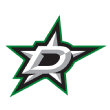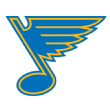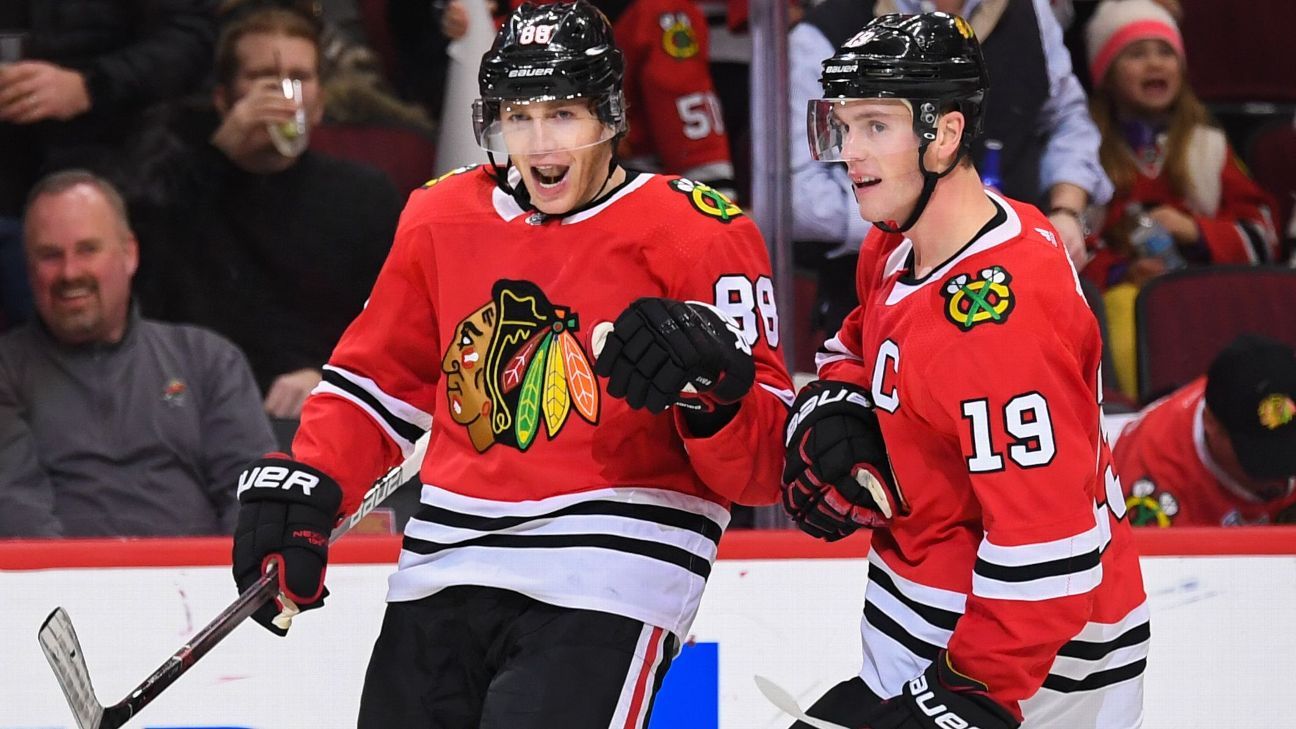Ahead of the free-agency shopping frenzy beginning on July 1, we’re surveying the landscape and outlining the unique situation in which every team finds itself. That includes the key pending unrestricted and restricted free agents and the team’s current cap space, along with the moves I’d make if I were sitting in the GM’s chair. We’ve already looked at the Atlantic and the Metropolitan, and this edition focuses on the seven teams in the Central.
Note: All contract information cited here is courtesy of Cap Friendly, and all underlying numbers are provided by one of Corsica, Natural Stat Trick or Evolving Wild.

Key players hitting UFA: C Marcus Kruger, W Chris Kunitz, G Cam Ward
Key players hitting RFA: C/W Dylan Sikura, W Brendan Perlini
Cap space: $11.94 million
The moves I’d make as GM: The Blackhawks are in a weird spot, in that they have essentially two different motives to juggle, and they’re doing their best to try and sync them up as neatly as possible. On one end, they still have the championship core of Jonathan Toews, Patrick Kane, Corey Crawford and Duncan Keith, with which they’d presumably like to make one more playoff run while at least the first two are still in their prime. But they’ve also now missed the postseason in back-to-back seasons, and need to realistically assess how plausible that goal is. It’s the hockey equivalent of trying to have your cake and eat it too, but the worry is that if you’re not careful you can wind up without either.
One thing GM Stan Bowman has done a sneaky good job of recently has been accumulating young forward talent without paying a real premium for it. Between Dylan Strome, Alex DeBrincat, Brendan Perlini, Dylan Sikura and Aleksi Saarela, there’s actually some real talent on the depth chart up front to help complement the big name stars at the top. But goal scoring wasn’t an issue for the Blackhawks last season, when they had the eighth ranked offense.
The issue is on the other end of the ice, where they were stunningly porous. Only the Senators gave up more goals than they did in 2018-19, which is less than ideal considering that’s a team that traded away all of its good players and actively tried not to spend money or win. Part of the problem is that they had to start 35-year-old Cam Ward 33 times because of Crawford’s extended health concerns, and that went about as well as you’d imagine (.897 save percentage, minus-7.8 goals saved above average).
It’s lazy to chalk up all of their problems to that however, because the play in front of the goaltending wasn’t much better. It’s tricky to figure out how much of that was on the personnel, which was subpar, and how much of it was on the system itself. The comedy of errors in the defensive zone was reminiscent of the Patrick Roy-coached Avalanche and the Doug Weight-coached Islanders, with there seemingly being no real plan for how they wanted to defend as a group. At the same time, Jeremy Colliton had the unenviable task of hurriedly coming in midseason, and taking over for a living legend in Coach Quenneville. It was a recipe for disaster, so it can’t be surprising that disastrous results followed.
The two big offseason moves they’ve made already will go a long way towards respectability, because both Olli Maatta and Calvin de Haan are strong in-zone defenders. De Haan is the better overall player, and it was a tidy piece of business by Chicago to jump at the opportunity to steal him from a Hurricanes team that had too many defensemen and was looking to shed salary. Maatta has his share of flaws, but what he lacks in foot speed he makes up for in stick work and positioning once he’s in his own zone. The combination of them in a vacuum isn’t anything too special, but for this particular Blackhawks team, it represents a significant upgrade at the position, especially considering the meager price they had to pay to acquire them.
It’s not all sunshine and lollipops however. I’d love to sit here and draw out a genius blueprint for how the Blackhawks can get out from under the Brent Seabrook contract and create more money to improve their team with. But because of the way it was structured, there are no real gains to be had from buying it out, and there’s such an untenable mix of term and real dollars left to be paid out that no team is taking it on without a number of sweeteners being attached to it. Chicago made their own bed, and now they’ll have to lay in it until a potential compliance buyout comes in the next collective bargaining agreement.

Key players hitting UFA: G Semyon Varlamov, C Derick Brassard, C/W Colin Wilson, D Patrik Nemeth
Key players hitting RFA: W Mikko Rantanen, D Nikita Zadorov, C/W J.T. Compher, C/W Alexander Kerfoot, C Vladislav Kamenev
Cap space: $38.90 million
The moves I’d make as GM: The rest of the league should be very, very concerned about what the Avalanche are building in Colorado right now. After a season in which they exceeded expectations by making it to within one game of the Western Conference finals, they look primed to take the next step and enter legitimate contender status at some point in the very near future.
No team currently has more than the near $40 million of cap space the Avalanche have to operate with this summer. Even after factoring in the gigantic new deal Mikko Rantanen earned with his 87-point season, they’ll have more than enough left over to throw some haymakers if they feel so inclined. They only added fuel to the fire after creating even more space when they flipped Carl Soderberg for Kevin Connauton this week, raising some eyebrows around the league as to what they could possibly have planned.
They’re going to lose Varlamov in free agency, but his brand name value exceeds his actual worth to the Avalanche at this point. Philipp Grubauer took the crease for himself with a scorching hot run to end the season, stopping a preposterous 94.8% of the shots he faced in 18 games after the All-Star break, and 92.5% of the shots he faced in another 15 playoff games after that. Considering that they have Pavel Francouz — who dominated the Czech league and KHL for years before coming over last season and posting a .918 save percentage in 49 AHL games — signed for cheap as well, it looks like they could very well enjoy the ultimate luxury of an above-average netminding tandem for under $5 million combined next season.
The biggest current need for the Avalanche looks like a center that can step in and provide them with a lethal 1-2 punch down the middle alongside Nathan MacKinnon. For as transcendent as MacKinnon, Gabriel Landeskog and Rantanen were as a group last season, if Colorado has aspirations of vaulting up a tier and being taken seriously as a title contender they’ll need another scoring line to materialize. It’s possible that Compher could eventually develop to become that guy, and it’s even more likely that recently drafted Alex Newhook becomes that guy for them once he’s done polishing his game at the NCAA level. With some potential future options in place, it would make sense for the Avalanche to target a shorter-term addition to step in to help bridge the gap in the present, whether it be through the free agent market or via trade.
Which brings us to Tyson Barrie, whose name has been circulating in trade talks of late. He’ll be turning 29 next summer, and is surely due for a mega pay day after next season considering the fact that he’s a right-handed shooting defenseman that’s piled up big point totals in recent campaigns. It’s understandable that the Avalanche wouldn’t want to pick up the tab on that, when they have Cale Makar, Samuel Girard and Bowen Byram ready to step up and devour all of those delicious offensive minutes should Barrie depart. If someone wants to pay a premium for his services now, it’s an enticing idea considering he could net a return that helps them more moving forward.
The Avalanche are positioned firmly in the driver’s seat at the moment. They have a main roster that’s not only incredibly fun to watch but ready to be competitive, a prospect group that’s now brimming with elite young pieces after they crushed the 2019 draft, and enough wiggle room financially to go out and get any pieces they identify as necessary for helping put it all together. All of that promise doesn’t actually guarantee anything, but they’re only a couple of well-timed chess moves away from truly building something special, which makes the Avalanche a team to watch this summer.

Key players hitting UFA: W Mats Zuccarello, W Brett Ritchie, C/W Jason Spezza, W Ryan Hartman, D Ben Lovejoy
Key players hitting RFA: C Jason Dickinson, D Julius Honka
Cap space: $10.96 million
The moves I’d make as GM: Much like the Avalanche, the Stars were far too top-heavy offensively last season, and their top priority this summer should be addressing that. The issue was particularly exemplified by how big of a difference having Mats Zuccarello around made once he finally jumped into their lineup (following the trade and subsequent injury he sustained in his first game with the team). Dallas looked like a completely different team in the playoffs than the relatively one-dimensional one they iced for much of the regular season, with Zuccarello unlocking Roope Hintz‘s potential and providing the Stars with another offensive dynamic.
In a vacuum, it’s understandable that they would balk at the idea of rewarding Zuccarrello with the four- or five-year term that he’s looking for with his next deal, considering that he’ll turn 32 before the season begins, but their current reality is that the team they’ve constructed is firmly situated in win-now mode. So if it’s not Zuccarello, then they’ll need to go out and find another playmaking winger that can help replicate the success he had driving a second scoring line.
From a timeline perspective, the Stars find themselves in a fascinating spot right now. Unlike most teams that are constantly trying to balance the present and the future, they’re pot committed financially to go for it with the current core over the next two to three seasons, based on how all of their most important contracts are structured.
For the next two seasons, they have Miro Heiskanen still on his entry-level deal and John Klingberg playing on one of the most team-friendly deals in the entire league. Who knows what the league will look like by then after the next CBA, but by the summer of 2022 not only will both of those players be significantly more expensive, there’s also the fact that: Alex Radulov’s deal will be up, Tyler Seguin will be on the wrong side of 30, Jamie Benn will be approaching his mid-30s and Ben Bishop will already be in his mid-30s. With such a well-defined time frame already drawn up to act aggressively, GM Jim Nill would be doing himself a disservice if he didn’t throw caution to the wind and go for it right now with this group.
If there’s one other area they could stand to improve, it’s with secondary defensemen to fill the depth chart out. It’s remarkable that the same team that realized the importance of — and invested heavily in — scintillating talents like Klingberg and Heiskanen can then turn around and believe that players like Ben Lovejoy and Roman Polak also deserve minutes at that same position. Obviously not every defenseman can be as offensively gifted and inclined as those first two, but it feels like there’s a happy medium when it comes to finding the right complements to pair with them. This Stars team is at its best when it’s in transition and attacking downhill with pace, and having more than just two players on the back end that can consistently get the puck up to their top forwards would go a long way. They simply threw away too many minutes last season without their best players on the ice, because all of their other options available were essentially black holes with the puck on their sticks.

Key players hitting UFA: W Pontus Aberg, C/W Eric Fehr
Key players hitting RFA: W Kevin Fiala, C Joel Eriksson Ek, C/W Ryan Donato
Cap space: $19.25 million
The moves I’d make as GM: The Wild are in a league of their own when it comes to toughest teams on which to get a good handle. They’ve been all over the place of late, taking two steps forward before immediately proceeding to take three more steps back. GM Paul Fenton certainly hasn’t been shy about making trades during his brief time in Minnesota as he tries to put his personal stamp on this roster he inherited, having closely learned from the master of the big trade David Poile during his days with the Predators. The issue is that unlike Poile, he’s been eating more losses than wins when doing so, making some decisions that can be generously described as puzzling along the way.
The latest example is their handling of Jason Zucker, which has been nothing short of bizarre. It’s tough to say what’s more inexplicable, the fact that they’ve been desperately trying to trade him for cents on the dollar or that they’ve been failing to do so and dragging this saga along further. Apparently the Nino Niederreiter debacle wasn’t a good learning experience, because this looks like another player that’s being completely devalued because of random factors that are out of his control.
Prior to this past season Zucker, was a 12.8% shooter, but dipped down to just 9.8% in 2018-19. If he’d converted the 214 shots he put on net at that same career average rate, he would’ve scored around 27 goals compared to the 21 he actually did. It’s hard not to wonder how much different the narrative around his performance would be if that were the case, or if there’d even be any urge from Minnesota’s perspective to dump him in a deal to begin with. He’s currently signed to a perfectly reasonable annual figure ($5.5 million) over the course of his age-27 through age-31 seasons, which is presumably the remaining meat of his most productive offensive years.
Having a coherent plan and then sticking to it is arguably the most important skill you can have as a GM, and the biggest failing of Minnesota’s latest moves is that they don’t appear to have one. When they traded Charlie Coyle for Ryan Donato and Mikael Granlund for Kevin Fiala, the explanation was that they were looking to get younger and faster as a team. Now they’re reportedly looking to trade one of their best skaters in Zucker for 31-year-old Michael Frolik or 32-year-old Phil Kessel, while also reportedly preparing to make a big offer in free agency to 31-year-old Wayne Simmonds, whose skating is certainly on the decline at this point of his career.
The biggest issue for the Wild moving forward is that it’s looking more and more like they’re stuck in mediocrity for the foreseeable future, which is undoubtedly the worst place you can find yourself in as a sports franchise. They have a lot of money tied up in a team that isn’t very good, and it’s unclear what they’re ultimately trying to accomplish. Based on his recent track record, it’s perfectly fair to wonder whether Fenton is the right person to be behind the wheel as they try to steer their way out of this position. Right now, all it looks like all they’re doing is just digging an even deeper hole for themselves with each passing move.

Key players hitting UFA: W Wayne Simmonds, C Brian Boyle
Key players hitting RFA: W Rocco Grimaldi, C/W Colton Sissons
Cap space: $13.19 million
The moves I’d make as GM: When the Predators went out and dumped P.K. Subban‘s contract at the draft, they may as well have showed their cards to the rest of the NHL. It’s no secret now that they’re planning on going hard after Matt Duchene in free agency, hoping to better spread their wealth of talent across the lineup by subtracting from a position of strength (their blue line) and adding to an area of weakness (their forward group).
In theory, the logic checks out. With Roman Josi, Mattias Ekholm and Ryan Ellis, they’re uniquely equipped to cover for the loss of Subban without a sizeable dropoff, especially if Dante Fabbro is also ready to step up and eat some quality minutes. You can only have those players out on the ice so much because there’s a clash of skill sets, and a point of diminishing returns is reached. Something the Predators could certainly use more of is game-breaking talent up front, because right now it’s basically Filip Forsberg, Viktor Arvidsson … and then everyone else.
The issue is that they basically gave away a player that was a Norris Trophy finalist just a year ago for what amounted to a bunch of magic beans, and now they’re going to immediately turn around and use that newfound financial breathing room to presumably overpay a player that is talented but hardly a sure thing to fix their current needs. Like with most unrestricted free agents, Duchene’s term is going to be wind up looking regrettable eventually, considering it’s likely going to take him well into his 30s.
What the Predators need to address this summer above all else is their woefully inept power play. Which is why their pursuit of Duchene is questionable, because he’s never been a particularly effective player there despite all the skill he possesses, traditionally doing most of his damage at five-on-five with his speed off the rush. Of the 427 players that have seen at least 200 minutes of power-play ice time over the past five seasons, his 3.33 power-play points per 60 minutes rank 276th, in the neighborhood of players like Carl Soderberg, Mikael Backlund and Nikolay Goldobin. This isn’t to say that he couldn’t help them produce there, it’s just that he never really has after being in the league for a decade now.
Anything could help at this point, because last season that group mustered a league-low 4.55 goals per hour with the man advantage, which is among the worst efficiencies the NHL has seen in the analytics era (dating back to 2007). In their first-round playoff matchup against the Stars, they went 0-for-15 in six games, which was a big reason why they were ultimately upset by the lower seed. Even the deadline acquisitions of Wayne Simmonds and Mikael Granlund, two historically top notch power-play producers, couldn’t help pull Nashville’s power play out of the gutter.
It’s presumably more of a systemic issue than a personnel one considering that the Predators do have more than enough talent not to be historically bad in that area. They’ve hired a new assistant coach in Dan Lambert to run that unit, and without Subban occupying the point they’ll hopefully finally move away from the ultra outdated three forward and two defenseman sets, and move towards the modernized four-forward formations. The bar they need to clear to improve heading into next season is remarkably low, but it could go a long way towards kick starting their offense.

Key players hitting UFA: W, Patrick Maroon, D Carl Gunnarsson
Key players hitting RFA: G Jordan Binnington, D Joel Edmundson, C Ivan Barbashev, C/W Oskar Sundqvist, W Sammy Blais, W Zach Sanford, C/W Robby Fabbri, G Ville Husso
Cap space: $17.22 million
The moves I’d make as GM: Unlike last summer, when Doug Armstrong was the busiest GM in the league on July 1st, signing Tyler Bozak, David Perron and trading for Ryan O’Reilly in one single day, this offseason will revolve around taking care of business in St. Louis. You’ll have to excuse the Blues for moving at a more leisurely pace this offseason; carrying the Stanley Cup around with you everywhere can take its physical toll.
St. Louis has a greater number of notable restricted free agents than any team we’ve previewed thus far, but it’s not much of a concern, because the majority of them are depth contributors that don’t have the eye-popping counting numbers to warrant big dollar figures. Jordan Binnington is the obvious exception, and it’ll be awfully interesting to see just how much the Blues are willing to commit to him after fewer than 60 total games combining both the regular season and playoffs. It’s worth remembering that he’s older than you’d think a player with his experience would be, as he’s already turning 26 this summer.
The Blues admittedly don’t have too many overwhelmingly glaring needs or areas of weakness to tend to at the moment. The biggest things they need to worry about are not getting complacent or overly sentimental following all of the success they just enjoyed, especially when it comes to handing out loyalty contracts. Where winning teams get themselves in trouble in the NHL is when they start paying players for what they’ve already done as opposed to what they’re projected to do.
Patrick Maroon is really the only name that profiles as a potential risk for that considering he’s 31, doesn’t have a body type that’ll age particularly gracefully, is a hometown boy, and already took a discount to come play for the Blues. But seeing as he only scored 10 goals and had 28 points last season, it’s hard to see that number inflating too catastrophically even if they do decide to reward him for everything this summer.
They were the deserving champions for a reason. They’re deep, they have good players at every position, and most of their team is firmly in its prime. It would be cool to see the Blues add another legitimately useful new piece or two to add a different dynamic to the team, avoid a Stanley Cup hangover by mixing things up a bit, and going for it again next season.

Key players hitting UFA: D Tyler Myers, W Brandon Tanev, D Ben Chiarot, D Nathan Beaulieu
Key players hitting RFA: W Patrik Laine, W Kyle Connor, C/W Andrew Copp, D Neal Pionk
Cap space: $23.87 million
The moves I’d make as GM: The Jets serve as the latest cautionary reminder of how fast things can change in this league, and how quickly future outlooks can be flipped on their head. Just one year ago, they were coming off a promising dash to the Western Conference final, and it was viewed as just the beginning for a team the entire hockey world was penciling in as a perennial contender for seasons to come.
Now they’re reeling after what was a disappointingly premature ending to an underwhelming season, facing loads of uncertainty about what they’ll even look like in the future as they start bleeding talent due to cap complications. It’s hard to feel too sorry for them, because it’s not like they can be surprised that this is happening. We knew this day was coming down the road, and they’ve handled it with the foresight of a college student that was procrastinating all semester before finally starting to cram the day of the final exam.
The Jacob Trouba situation was horribly mishandled, but that had been bubbling for a long time before the actual trade itself came through. They didn’t get the most out of him early in his career, playing him with suboptimal defense partners, and then alienated him with a bridge deal once his entry-level contract was up. The end result was a tough one to swallow all the same, because they just turned a top-pairing right-handed shooting defenseman that’s entering the prime of his career into not a single thing that’ll tangibly help them compete for a Stanley Cup next season. They’re better off letting Tyler Myers walk in free agency considering the outlandish offers he’s reportedly fielding, but the biggest concern is the next domino to fall after that.
The Jets are reportedly exploring the possibility of flipping Nikolaj Ehlers for a defenseman to make up for losing Trouba and Myers in the same offseason, which would amount to trying to cover up one hole by making another bigger one elsewhere. Selling low on Ehlers now after a down season would be a mistake, because he’s an excellent talent and an incredibly useful asset. He’s signed at a cost-controlled rate of $6 million per season for his age-23 through age-29 seasons. He draws a ton of penalties — only Connor McDavid, Johnny Gaudreau, Aleksander Barkov and Jeff Skinner have a better five-on-five penalty differential than he does since entering the league — he’s a puck-carrying monster through the neutral zone, and he’s the perfect player for today’s modern game in so many ways.
As a thought exercise, it’s fun to consider which combination you’d be able to squeeze more value out of if you’re the Jets: Nikolaj Ehlers and the affordable contract he’s already signed to plus whatever king’s ransom you’d get for Kyle Connor after he just scored 34 goals, or Kyle Connor and the full freight contract you’ll pay for him while his market value is sky high, plus whatever you’d get for Nikolaj Ehlers with his stock lower than it’s likely ever going to be again. Seems pretty obvious from this vantage point.
How they handle Patrik Laine’s next contract will be fascinating. He took as much heat as anyone for his performance last season, but maintaining some perspective is important. In an admittedly poor season for the Finn, he still scored 30 goals. If the 12.2% he shot last season — after being just south of 18% in his first two seasons — wound up being the lowest figure he converted at over his peak years, it would be believable considering the nearly unmatched shot talent he possesses. It’s the most silver of linings, but if it suppresses the amount of money he’s able to fetch this summer it could potentially be a blessing in disguise for Winnipeg. Going the bridge route in an attempt to see how the rest of his game develops before fully committing to him financially possesses too much needless risk in this case, because he’s incredibly unlikely to stop scoring an obscene amount of goals all of a sudden, which means that the dollar figures on the next deal will only keep escalating with each goal off his stick.
The Jets can still salvage this entire situation and get their team back on track, because they still possess a ton of talent and haven’t made any truly irreparable mistakes yet. But every so often, we see a team that flames out in a particularly unseemly manner in the postseason and irrationally overreacts the following summer in the pursuit of washing that bitter taste out of their mouths. Winnipeg is as good a candidate as any to fill that role this summer, with the Trouba move and the following murmurings doing nothing to quell those lingering concerns.
